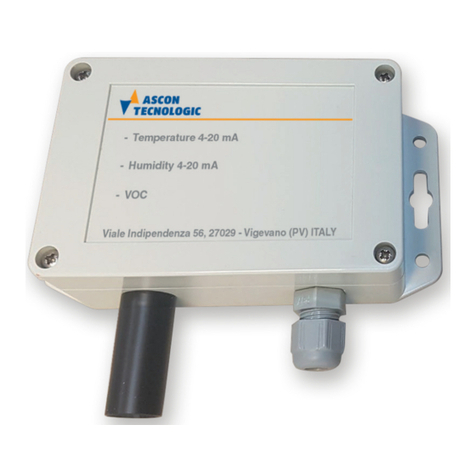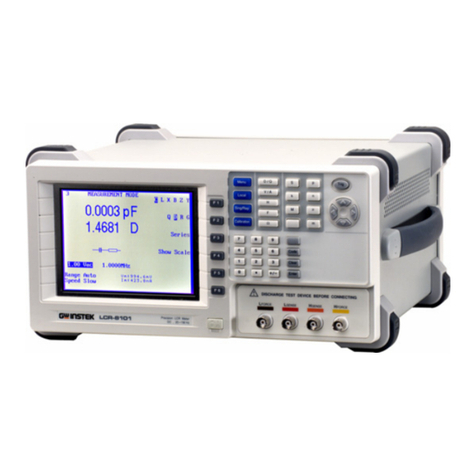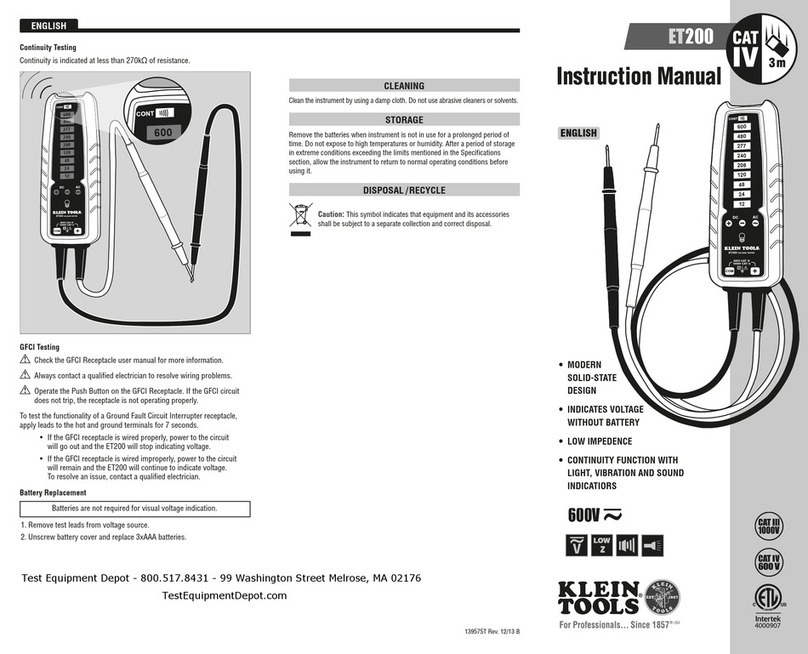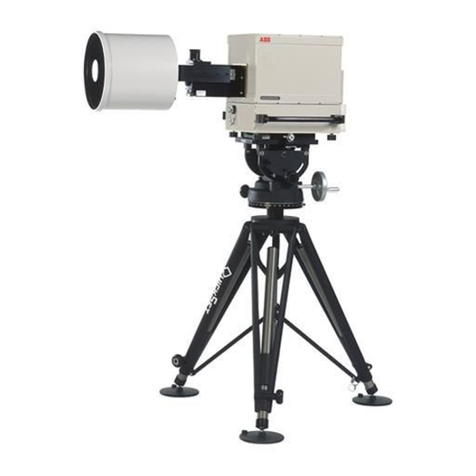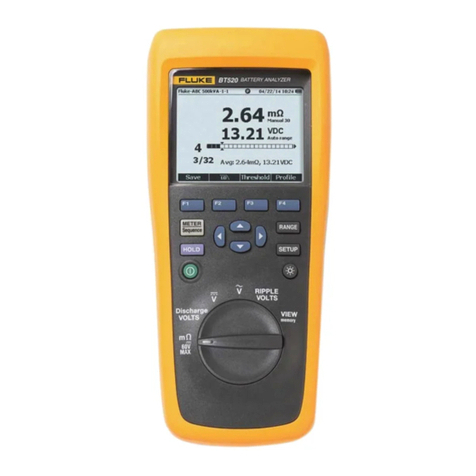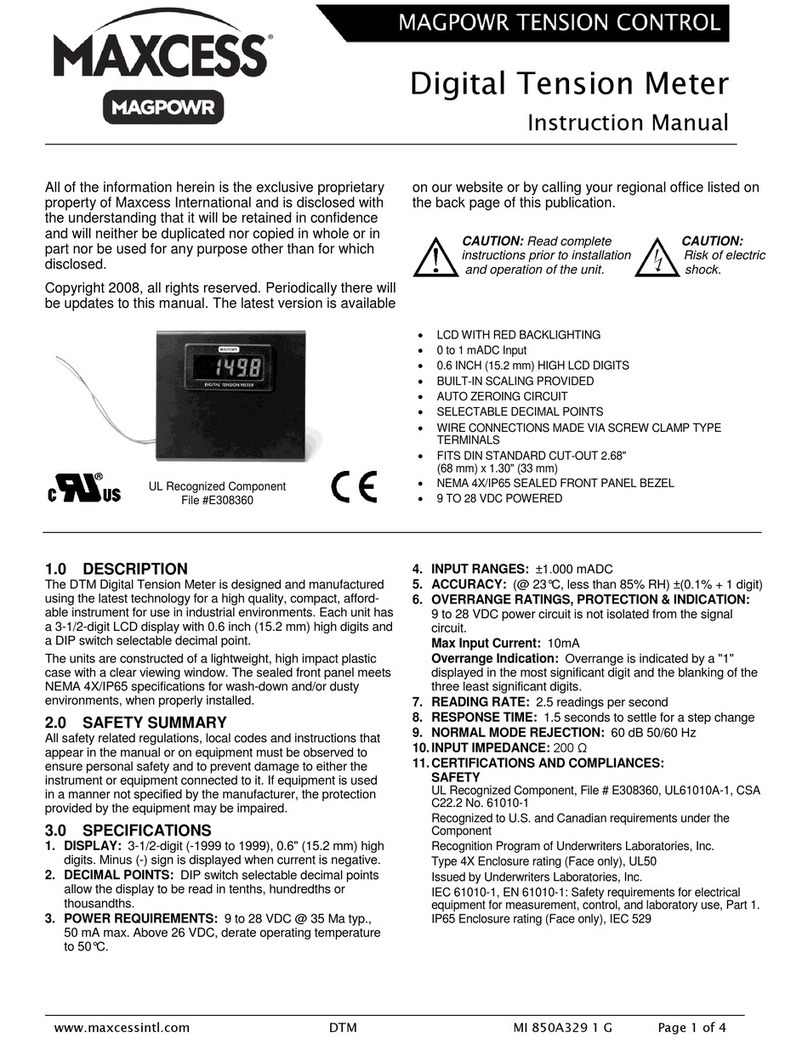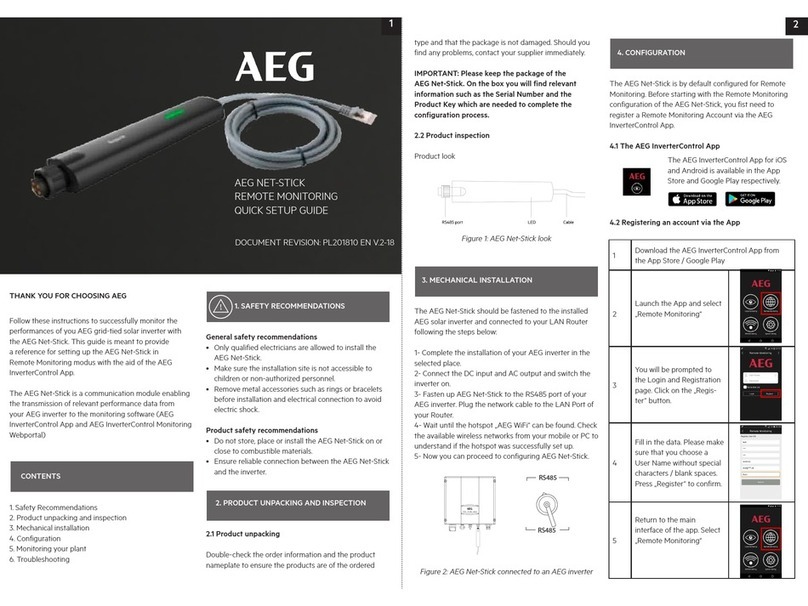Gemco Semelex Safetimeter 1999 Series User manual

Semelex®Safetimeter
Operating Manual
Series 1999
1999SEMC
SELF-CONTAINED, PORTABLE
ELECTRONIC STOP-TIME METER

Contents
Chapter 1: Overview ................................................................................................. 1
1.1 Safetimeter Switches and Connectors.................................................................. 3
1.2 Theory of Operation .............................................................................................. 4
Chapter 2: Unpack & Set-Up .................................................................................... 4
2.1 Set-Up and Test ................................................................................................... 4
Chapter 3: Operating Instructions .......................................................................... 5
3.1 Placement of Position/Velocity (P/V) Transducer .................................................. 5
3.2 Set the Control Start Point (CSP) ......................................................................... 6
3.3 Set the TIME UP/TIME DOWN Switch .................................................................. 7
3.4 Using Auto-Hand .................................................................................................. 8
3.5 Using Auto-Flag with Auto-Hand ......................................................................... 9
3.6 Using Optional Manual Start Switches ................................................................. 9
3.7 Using Optional Remote Tachometer .............................................................. .....10
3.8 Test Presses Running in a Continuous Mode...................................................... 11
3.9 Set Press Counterbalance................................................................................... 12
3.10 Test Full Revolution Clutch Presses .................................................................. 12
Chapter 4: Certification and Warranty................................................................... 13
4.1 Annual Calibration ............................................................................................... 13
4.2 Optional 5 Year Warranty..................................................................................... 13
Chapter 5: Specifications ....................................................................................... 14
Copyright 1999 by AMETEK Factory Automation
All Rights Reserved - Made in the U.S.A.
Version 1.0
AMETEK has checked the accuracy of this manual at the time it was printed.
Any comments you may have for the improvement of this manual are welcomed.
AMETEK reserves the right to revise and redistribute the entire contents or selected
pages of this manual. All rights to the contents of this manual are reserved by
AMETEK.

1
Operation Manual
Chapter 1: Overview
The SEMELEX is a self-contained, portable, multi-purpose diagnostic system for press room automation and operator
safety device analysis. The Semelex can quickly calculate machinery stopping time and determine the minimum safe
distance for safety devices including light curtains, palm buttons, E-Stop and safety mats.
The 1999SEMC Semelex II Safetimeter Test Set is field proven to accurately measure press stop time and safety
distance to verify compliance with federal and state requirements. Designed for harsh industrial environments, the unit
is portable, light weight, battery operated, and easy to use.
The Semelex Safetimeter is capable of measuring elapsed time, stop time (Ts) from 1-9999 milliseconds. It also
calculates the minimum safety distance (Ds) based on the OSHA formula, as understood by the factory, and will display
up to 999.9 inches to the nearest 0.1 inches.
The Semelex II Safetimeter Test Set consists of three components:
Safetimeter This is the “brains” of the unit, with processing electronics
that display the test results. The case is made from a highly visible yellow
plastic resin. The case is lightweight, waterproof, crushproof, dust proof and
has die cut foam inserts for the Auto-Hand and Position/ Velocity Transducer.
These tough cases are designed with an automatic purge valve, that equalizes
air pressure, a watertight silicone O-ring lid, over-molded rubber handles and
stainless-steel hardware.
Position/Velocity Transducer (P/V) This motion and position
sensor attaches to the press with its magnetic base and cable magnets.
Auto-Hand (A/H) This hand-held device is used to automatically
release a run control or press an E-Stop control on the press.

2
Series 1999SEMC Semelex® Safetimeter
6380 Brockway Rd, Peck, Michigan 48466 • Phone: 248-435-0700
Auto-Flag (A/F) This assembly is attached to the Auto-Hand to test
presses equipped with electronic guards, i.e. photoelectric barrier
guards (light curtains) or capacitance type guards (conduit rail sensors).
Optional:
Manual Start Switch This switch plugs into the MANUAL START jack on the
Safetimeter panel and are used to manually start the Safetimeter timing.
Remote Tachometer with Magnetic Base The tachometer replaces the P/V
Transducer when testing high speed or continuous stroke presses that can’t stop
within one stroke. With the wheel attachment, it can be used to test conveyors or
indexing tables. The 1999SEMC case is designed in such a way that the Remote
Tachometer can be stored in the case. Simply modify the lower piece of foam to
store the Remote Tachometer. Consult factory for diagram of foam cut-out.

3
Operation Manual
1.1: Safetimeter Switches and Connectors
ON/OFF This is the unit’s power button. The button can be depressed to turn it ON or OFF.
There is a timer sequence built into the controller that will time out after a fixed
duration of time if the meter is not being used. The power cord may be plugged into
120 VAC outlets for recharging the battery, in the ON or OFF position. The controller is
designed to operate from its internal battery.
TIME UP/TIME DOWN This switch determines the direction of the test. In the TIME DOWN position, the
controller will send a signal to the Auto-Hand to release the plunger in the down
direction. In the TIME DOWN position, you are performing a standard test according
to OSHA requirements. The switch should be in the TIME UP position when checking
press top stop.
STOP TIME
(mSEC)/ SAFETY
DISTANCE (IN)
This switch is used to select the display mode, either time or distance. Time is
measured in milliseconds and distance is measured in inches. The switch can be
thrown before or after the reading to convert form STOP TIME to SAFETY DISTANCE
or SAFETY DISTANCE to STOP TIME.
FULL REV/PART REV This switch is used to determine the press clutch operation mode, either full or part
revolution. The majority of tests are run in the part revolution mode.
CONTROL START
POINT (IN)
Known as CSP, this dial is used to set the point in the stroke at which the command to
start timing and fires the Auto-Hand is given. When the CSP dial is turned clockwise,
the dial will increment and decrement when turned counterclockwise. The CSP dial
reads in tenths of an inch. Example: 123 equals 12.3”.
MANUAL START This jack is used with the optional manual start switch.
AUTO-HAND This connector is used to connect the Auto-Hand to the Safetimeter.

4
Series 1999SEMC Semelex® Safetimeter
6380 Brockway Rd, Peck, Michigan 48466 • Phone: 248-435-0700
1.2: Theory of Operation
The P/V transducer measures the open height of a press. When this measurement coincides with the preset CSP
position, and the ram is traveling in the direction selected on the TIME UP/TIME DOWN switch, the Auto-Hand will
release one of the two run controls or press an E-STOP control to initiate the press stop. When the ram stops, the P/V
transducer sends a stop signal to the Safetimeter and the meter displays either stop time or safety distance, whichever
display mode was selected prior to the test.
NOTE: No OSHA standard exists for defining when a press has stopped (at what ram velocity). The Safetimeter ends its
measurement when the ram velocity is approximately .17 inches per second (10 inches per minute). When measuring
stop time, you must take into account all elements and devices used to bring the ram to rest. These include the “flight
time” of the run and E-STOP buttons (time for switch to activate), control relays, solenoids valves and clutch and brake
mechanical elements. Where an electronic guard (light curtain) is used, response time of the device and the depth
penetration factor must be added to that measured by the Safetimeter before calculating safety distance. Response
time is generally stated by manufacturers of electronic guards. However, to verify systems, the Auto-Flag can be used.
Chapter 2: Unpack & Set-up
The Series 1999 Semelex II Safetimeter has been carefully inspected and tested before shipment. Unpack the unit
and perform a visual inspection to assure that no damage has occurred during shipping. If damage is found, notify
the transportation company immediately. Only the consignee may institute a claim with the carrier for damage during
shipment.
2.1: Set-Up and Test
1. The Safetimeter battery is shipped with a partial charge. Plug in the unit and charge the battery until the green LED
goes off (maximum charge time is eight (8) hours).
2. Connect the P/V transducer with the appropriate connector.
3. Connect the Auto-Hand cable to the controller.
4. Make the following Safetimeter switch settings:
Display SAFETY DISTANCE (IN)
Revolution PART REV
Timing Direction TIME DOWN
Control Start Point (CSP) 200 (20.0 inches)
5. Push the ON/OFF switch ON.
6. Place the P/V transducer on a metal desk or steel plate. The magnetic base will hold the unit in place.
7. Carefully slide the cable magnet from its keeper. Do not let the cable run free, it can be damaged by impact from
sudden release. Pull the cable magnet out approximately 24 inches.
8. Bring the magnet back towards the P/V transducer. The P/V transducer will reel in the cable automatically. When
the cable magnet is about 20 inches from the base of the P/V transducer, the Safetimeter will send a command to
the Auto-Hand and the controller will start counting. The unit will continue counting as long as the cable velocity
is .17 inch per second (10 inches/minute) or greater.

5
Operation Manual
9. Stop the cable from rewinding or pull the magnet out. The display will stop counting and show the results.
10. Again, pull the cable out approximately 24 inches. The display’s current value will remain because the Safetimeter
is set in the TIME DOWN direction.
11. Let the cable rewind. The display will reset to “0” and start counting. The zero reset occurs automatically at the
beginning of the count and cannot be seen.
NOTE: The Safetimeter will count when the cable is rewinding and stop when the cable stops, or the direction is
reversed.
12. Change the TIME UP/TIME DOWN switch to the TIME UP position and start with the cable rewound. The
Safetimeter will begin to count in the UP direction when the 20-inch CSP setting is reached and continue until the
cable stops or the direction is reversed.
13. Set the CSP dial to several values and check that the Safetimeter begins to count at the preset positions when the
cable is moving in the direction selected by the TIME UP/TIME DOWN switch.
14. If the optional Manual Start Switch is available, continue with steps 14-15. If not, move to Chapter 3: Operating
Instructions.
15. Plug the Manual Start Switch in the MANUAL Start jack. If the Safetimeter is ON, the counter will begin to run.
Switch the Safetimeter OFF and then ON to reset the counter.
16. If the Manual Start Switch is normally closed (red plug), the Safetimeter will begin to count when the switch is pushed. If
the Manual Start Switch is normally open (black plug), the Safetimeter will begin to count when the switch is released.
Note: The Normally Closed switch has been obsoleted and is no longer available for sale.
Chapter 3: Operating Instructions
3.1: Placement of Position/Velocity (P/V)
Transducer
1. Position the magnetic base of the P/V transducer on a clean
area of the press’s bed or bolster plate.
2. Extend the cable magnet to the ram in a straight line,
perpendicular to the transducer and attach the magnet to
the ram. A test will not start at 90 degrees if the cable is
angled.
3. Connect the P/V transducer to the Safetimeter using the
cable provided.
CAUTION: Never place the transducer where the press or dies can close in on it. Also, be sure when the press closes,
the transducer still has some cable extended to keep it from slamming the magnet into the body of the transducer.

6
Series 1999SEMC Semelex® Safetimeter
6380 Brockway Rd, Peck, Michigan 48466 • Phone: 248-435-0700
3.2: Set the Control Start Point (CSP)
There are three ways to set the CSP depending on the following conditions.
Proceed to the section that best fits your condition.
A. Setting the CSP dial when the press stroke is known.
B. Setting the CSP dial when the press stroke is not known.
C. Setting the CSP dial at the 90-degree crankshaft position.
A. Setting the CSP dial when the press stroke is known.
1. Raise the press to the top of its stroke.
a. Set the TIME UP/TIME DOWN switch to TIME DOWN position.
b. Set the FULL REV/PART REV switch to PART REV.
c. Select either STOP TIME (mSEC) or SAFETY DISTANCE (IN) display.
2. Switch on the Safetimeter.
3. Turn the CSP dial clockwise until the Safetimeter begins to count.
4. Switch the Safetimeter OFF and then ON to stop the counter.
5. Turn the CSP dial counterclockwise somewhere below the reading where the Safetimeter began to count.
6. Slowly turn the CSP dial clockwise and stop when the Safetimeter begins to count. The number displayed in the
CSP dial is the distance between the base of the P/V transducer and the ram.
7. Subtract 1/2 of the press stroke from the number displayed in the CSP dial to calculate the Control Start Point.
Example: If the number displayed in the CSP dial is 240 (24.0”) and the press stroke is 6”, subtract 3” (1/2 stroke)
from 24.0” equals 21.0”. This is the mid-stroke position. While it may not represent the exact 90-degree point of the
crankshaft, it is close. This electronically measured point in the stroke will start the Safetimeter and fires the Auto-Hand.
8. Set the CSP dial to the result of Step 8. From the example, the CSP dial would be set to 210 (21.0”).
B. Setting the CSP dial when the press stroke is not known.
1. Find the open height of the press by performing steps 1-7 in subsection (A). Record the distance determined in
step 7.
2. Lower the press ram to the bottom of the stroke. Find the closed height of the press by performing steps 2-7 in
subsection (A). Record the distance determined in step 7.
3. Using the two distances determined from steps 1 and 2, calculate the mid-stroke position using the following
method: Add the two measurements together and divide by two (2).

7
Operation Manual
Example: Midstroke = (Open Height + Closed Height) ÷ 2.
If the number displayed in the CSP dial is 240 (24.0”) when the Ram was fully UP and the number displayed on the CSP
dial is 0120 (12.0”) when the Ram was fully DOWN, that tells us that the 90º point will be 18.0” (24.0” + 12.0” = 36.0”
÷ 2” = 18.0”). While it may not represent the exact 90-degree point of the crankshaft, it is close. This electronically
measured point in the stroke will start the Safetimeter and fires the Auto-Hand.
4. Set the CSP dial to the above result.
C. Setting the CSP dial at the 90-degree crankshaft position.
To test at the 90-degree crankshaft position, or when the P/V Transducer cable is angled, the CSP will act as a
reference setting.
1. Inch the press to 90 degrees by observing the crankshaft or stroke indicator.
2. Perform steps 2-6 in subsection (A).
3. The distance determined in step 6 (number displayed on the CSP dial) is the 90-degree point of the crankshaft,
which includes allowance for the cable angle.
NOTE: When testing the top stop, the distance determined in step 3 will correspond to the 270-degree position of the
crankshaft when the TIME UP/TIME DOWN switch is in the TIME UP position.
3.3: Set the TIME UP/TIME DOWN Switch
The TIME UP/TIME DOWN switch is used to select the direction the press
(closing or opening) is moving when the automatic stop command is given.
This switch must be properly set even when a manual test, with the optional
manual start switch, is performed.
NOTE: The Gemco Semelex II Safetimeter has the capability to check both
down and up stop times to aid in setting the press counterbalance. For best
results, the down stop time test should be initiated at 90 degrees, and the up stop time should be initiated at 270
degrees. During these tests, it is important to stop the ram before the dies engage on the down stoke and before
top dead center on the up stroke. On some presses, however, the ram may take more than 90 degrees to come to a
complete stop. If so, adjust the CSP as follows:
1. On the down stop time test, increase the Control Stop Point (CSP) setting to initiate a stop between 0 and 90
degrees. Continue increasing the CSP and testing the press until the ram can be stopped before the dies engage.
2. Similarly, on the up stop time test, decrease the CSP setting to initiate a stop between 180 and 270 degrees.
Continue decreasing the CSP and testing the press until the ram can be stopped before top dead center.
It is important to test both the down and up stop times using the same press control. Typically, an inch button or two-
hand control in the inch mode is used since the up stop time test is not possible in the single-stroke mode with two
hand controls. Safety distance and/or stop time tests must be performed after setting the counterbalance to ensure
proper press operation and guarding. Adjusting the counterbalance air pressure to obtain near equal down and up stop
times will set the counterbalance at is optimum point.

8
Series 1999SEMC Semelex® Safetimeter
6380 Brockway Rd, Peck, Michigan 48466 • Phone: 248-435-0700
3.4: Using Auto-Hand
The Auto-Hand is designed to release or push press controls.
It can release a two-hand control, inch button or push an
E-Stop button.
Using Auto-Hand with Two Hand or Inch Control (Release
to Stop)
The Auto-Hand releases or pushes buttons with a spring-
loaded plunger. When the plunger is pushed, it will latch into position. The Safetimeter provides a voltage pulse to
energize a solenoid that releases the spring-loaded plunger. If the two-hand control has a ring guard, the Auto-Hand
should rest on the guard and the three support legs are not needed. There is a plunger extension in the accessory bag
that can be screwed into the Auto-Hands plunger if the plunger is too short to reach the button in question.
1. Connect Auto-Hand to the Safetimeter. Depress the plunger and place the extended end over one of the two-hand
buttons. Rest Auto-Hand on the button’s ring guard. If no ring guard exists, screw in the three legs to serve as a rest.
Use your other hand to press the other button.
2. Cycle the press. The Auto-Hand will actuate when the desired CSP is reached, releasing the button and initiate a press
stop.
NOTE: The Auto-Hand can only release 10 lbs. of force and may not release if pushed against the button with excessive
force. In this case, use one leg as a spacer, to prevent applying excessive force. Place over switch and repeat step 2.
NOTE: Be sure the press has stopped before the bottom of the stroke. Readings are invalid if the press goes through the
bottom of the stroke before stopping. If this happens, increase the CSP setting slightly until the press stops before the
bottom.
3. Read the Safetimeter display. This value is the Stop Time or Safety Distance, depending on the display mode selected
prior to the test.
4. Remove Auto-Hand and restart the press to return the ram to top stop.
Using Auto-Hand with and E-STOP Button (Push to Stop)
1. Screw the plunger extension into the plunger end that retracts when the plunger is depressed. This end is used to push
an E-STOP button. Attach the three legs to this side, if required.
2. With the Auto-Hand plunger depressed, place the unit over the E-STOP button to be pushed. Check that the plunger
extension is adjusted out far enough to push the button when the Auto- Hand releases.
3. Position the Auto-Hand over the E-STOP button. The plunger extension should not touch the E-STOP button.
4. Cycle the press while holding Auto-Hand over the button. Auto-Hand will operate when the desired CSP is reached
and push the E-STOP button, stopping the press.

9
Operation Manual
3.5: Using Auto-Flag with Auto-Hand
Auto-Flag is used in conjunction with Auto-Hand to test the entire press control
loop which includes electronic guards, i.e. photoelectric barrier guards (light
curtains) or capacitance type guards (conduit rail sensor).
This test initiates a press stop by obstructing the sensing area with Auto-Flag,
causing the guard to activate a stop signal in the press.
Attaching Auto-Flag to Auto-Hand
1. Screw the Auto-Flag into the retracted end of the plunger when the Auto-Hand
plunger is depressed. Adjust the Auto-Flag so that it is just outside of the light
curtain.
2. Rest the Auto-Hand with Auto-Flag against the light curtain enclosure just
outside the sensing area.
3. Now, set up the Safetimeter and the P/V Transducer as described earlier to run a test.
4. Cycle the press. When the ram crosses the 90-degree point (position in the stroke desired to initiate a press stop),
the Auto-Hand will release the flag into the sensing area initiating a press stop.
NOTE: During this test, verify that when the press stops, the dies have not fully engaged, and the press has not gone
through the bottom of its stroke. If either situation occurs, increase the CSP setting slightly and repeat the test. The
displayed stop time is the total of the electronic guard delay plus press control and braking effectiveness. If desired,
the OSHA formula for safety distance can be read directly from the Safetimeter display. Toggle the STOP TIME/
SAFETY DISTANCE switch to see the displayed results for STOPPING TIME or SAFETY DISTANCE. Presses using
electronic guards have other mandated control requirements (brake monitors, for example) which should be in place
and operating correctly.
Note: When determining SAFETY DISTANCE for light curtains, the depth penetration factor must be added to
the Safetimeter reading.
3.6: Using Optional Manual Start Switches
The Safetimeter can be used in a manual mode with one of two optional Manual
Start Switches. These switches are plugged into the MANUAL START jack on
the Safetimeter panel. No wiring to the press control is required.
1. Normally Open Switch (PSD0110400). Designated with a black plug. Used
over an inch button or two-hand control, this switch starts the Safetimeter
timing when released.

10
Series 1999SEMC Semelex® Safetimeter
6380 Brockway Rd, Peck, Michigan 48466 • Phone: 248-435-0700
2. Normally Closed Switch (PSD0110309). Designated with a red plug. Used over an E-STOP button, this switch starts
the Safetimeter timing when pressed. Note: The Normally Closed switch has been obsoleted and is no longer
available for sale.
Perform the following Steps:
1. Set the TIME UP/TIME DOWN, FULL REV/PART REV, and STOP TIME/SAFETY DISTANCE switches as required.
2. Mark the ram or slide and frame with chalk, paint, etc. at the 90-degree point.
3. When the marks are aligned during the stroke of the press, release or push the Manual Start Switch being used.
This takes practice to get into sync with the press. Ten to 20 strokes may be needed. Be sure the readings are fairly
repetitive. Using the Manual Start Switches is less accurate than Auto-Hand.
4. The Manual Start switch can also be used in conjunction with the Auto-Hand. In many cases the manual start
switch can be used to throw the Auto-Flag through a light-curtain to initiate a stop.
3.7: Using Optional Remote Tachometer
For testing continuous stroke or high-speed presses perform the following steps:
1. Connect the Remote Tachometer to the P/V Transducer cable in the Safetimeter case. When
using the Remote Tachometer, the P/V Transducer is not used.
2. Position the Remote Tachometer on the press (machine) with the magnetic base. Center the
rubber nose cone on the rotating shaft, such as a press’s crankshaft or cam switch shaft.
Good axial alignment is needed.
NOTE: If the shaft rotation, viewed by the tachometer, is clockwise, toggle the TIME UP/TIME
DOWN switch to TIME UP. If the shaft rotation is counterclockwise, toggle the switch to TIME
DOWN. Toggle the STOP TIME/SAFETY DISTANCE switch to STOP TIME.
3. If the press is to be tested from the E-STOP button, use the normally closed (red) Manual Start Switch. (See section
3.6: Using Optional Manual Start Switches). When testing the press RUN or INCH button(s), use the normally open
(black) Manual Start Switch.
4. Choose the correct switch and plug it into the Manual Start jack on the controller.
5. Tape the switch temporarily over the control button. Cycle the press. When pressing the Manual Start Switch and
E-STOP button simultaneously, the press begins to stop and the Safetimeter starts counting. After the press stops,
the Safetimeter displays STOP TIME in milliseconds. Similarly, the Normally Open Manual Start Switch released
simultaneously with the RUN or INCH button starts the Safetimeter counting upon release.
NOTE: Run several tests, initiate stops at the same position in the stroke. Results should be fairly repetitive. Use only
the largest values in determining safety distance to be used. Prudent judgement suggests adding 10% to 20% to the
readings being measured.
NOTE: The Auto-Hand with Auto-Flag option can also be used with the Remote Tachometer. In this scenario,
depending on which manual start switch you are using, simply press or release the button on the downward stroke to
initiate the controller to start a measurement and release the Auto-Flag through the Light Curtain.
Note: When determining SAFETY DISTANCE for light curtains, the depth penetration factor must be added to
the Safetimeter reading.

11
Operation Manual
3.8: Test Presses Running in a Continuous Mode
Because the Safetimeter sends a release command to the Auto-Hand each time the P/V transducer crosses the
Control Start Point (CSP), a special method must be used to test a press running in a continuous mode. Typically, this
test is performed on the press’s Emergency Stop (E-STOP) button or a presence sensor.
1. Position the P/V transducer as described in Section 3.1: Placement of Position/Velocity (P/V) Transducer.
2. Set the CSP to initiate a stop at the 90-degree crankshaft position.
3. Ready Auto-Hand to press the E-STOP button or interrupt the presence sensor with Auto-Flag.
4. Make the following Safetimeter switch settings:
Display (as desired)
Timing Direction TIME DOWN
Revolution PART REV
5. Press the Safetimeter power switch OFF.
6. Start the press in continuous mode.
7. Observe that the press is up to speed.
8. When the ram is on the up stroke, press the power switch ON. When the ram goes through the top of the stroke
and crosses the 90-degree point, Auto-Hand will release and press the E-STOP button or interrupt the presence
sensing field with Auto-Flag.
9. After the press stops, verify that the ram has not gone through the bottom of the stroke or that the dies have
engaged. If either of these conditions have occurred, the reading is inaccurate. Increase the CSP setting slightly
and test until neither of these conditions occur.
NOTE: In some cases, stopping a continuous run press requires more than one stroke of the ram. The standard
Semelex II Safetimeter is incapable of testing such an occurrence. To perform this type of test, the optional Remote
Tachometer is needed. Contact the factory for details.

12
Series 1999SEMC Semelex® Safetimeter
6380 Brockway Rd, Peck, Michigan 48466 • Phone: 248-435-0700
3.9: Set Press Counterbalance
The Gemco Semelex II Safetimeter has the capability of checking both down and up stop times to aid in setting the
press’s counterbalance. For best results, the down stop time test should be initiated at 90 degrees and the up stop
time test at 270 degrees. It is important to stop the ram before engagement of the dies on the down stroke, and
before top dead center on the up stroke. However, on some presses, the ram may take longer than 90 degrees to
come to a complete stop. Test this condition as follows:
1. On the downward stop time test, increase the Control Start Point (CSP) setting to initiate a stop between 0 and 90
degrees. Continue increasing the CSP and testing the press until a down stop of the ram can be made before the
dies have fully engaged.
2. On the upward stop time test, decrease the CSP setting to initiate a stop between 180 degrees and 270 degrees.
Continue decreasing the CSP and testing the press until an upward stop of the ram can be made before the top
stop.
NOTE: It is important to test both the down and up stop times using the same press control. Typically, an inch
button or two-hand control in the inch mode will be used since an up stop time test is not possible in the single
stroke mode using a two-hand control. Adjust the counterbalance to obtain equal down and up stop times. This
sets the counterbalance at the optimum point. Always follow the press manufacturer’s recommendations when
setting the counterbalance. Several safety distance and/or stop time tests must be performed after the setting of the
counterbalance to ensure safe press operation and guarding.
3.10: Test Full Revolution Clutch Presses
Calculating the safety distance of a full revolution clutch press per OSHA 29 CFR 1910.217(c)(3)(viii)(c) is as follows:
Dm=63 inches/second x Tm; where:
Dm=Minimum safety distance (inches);
63 inches/second = hand speed constant:
and
Tm = the maximum time the press takes for die closure after it has been tripped (seconds). For full revolution clutch
presses with only one engaging point, Tm is equal to the time necessary for one and one-half revolutions of the
crankshaft.
For full revolution clutch presses with more than one engaging point, Tm shall be calculated as follows:
Tm = [1/2 + (1 / Number of engaging points per revolution)] x time necessary to complete one revolution of the
crankshaft (seconds).
The Safetimeter can aid in calculating safety distance of a full revolution clutch press by measuring the time
necessary to complete one revolution of the crankshaft.
Perform the following steps:
1. Set the FULL REV/PART REV switch to FULL REV.
2. Set the TIME UP/TIME DOWN switch to TIME UP.
3. Set the STOP TIME/SAFETY DISTANCE switch to STOP TIME.
4. Position the P/V transducer as described in Section 3.1: Placement of Position/Velocity (P/V) Transducer.
5. Push the Safetimeter power switch to ON.
6. Cycle the press. The Safetimeter will begin counting when the ram begins to travel down and will stop counting
when the ram stops on the up stroke. The Safetimeter will display the time for one stroke of the press.

13
Operation Manual
Chapter 4: Certification and Warranty
The factory certifies that the Gemco Series 1999 Semelex II Safetimeter has been inspected and tested at the factory
prior to shipment and meets requirements defined by the contract under which it is furnished.
All products of the factory are warranted against defective material and workmanship for a period of one year from
the date of delivery. The factory will repair or replace, at their option, all defective equipment returned (transportation
charges prepaid) during the warranty period without charge, provided there is no evidence that the equipment has
been mishandled or abused. This warranty does not apply to expendable parts or materials whose normal life is
less than the warranty period, nor is the factory liable for consequential damages arising out of use or handling of its
products.
4.1: Annual Calibration
Semelex Safetimeter is a safety device that is used to measure
stopping time and calculating safety distances. It is highly
recommended that the device be returned to the AMETEK factory
on an annual basis for inspections and calibration. There is a sticker
on the inside panel that will show when your unit is due for its next
calibration. To start the calibration process, simply send an email to
(RMA) Number.
4.2: Optional 5 Year Warranty - (1999OPT5YRWRNTY)
The Semelex II Safetimeter Optional Five Year Limited Warranty Limited Warranty Plan Includes:
1. Limited Warranty Seller warrants its products against defects in workmanship and materials of the items
purchased under this order provided, however, that notice of such defect is received in writing by Seller within
five years from the date of delivery of the item under this order. Seller’s liability under this clause is restricted to
replacing, repairing, or issuing credit (at Seller’s option) for any return unit and only under the following conditions:
(1) Seller must be properly notified in writing as soon as possible after the defects have been noted by the
customer, but no later than five years from date of delivery. (2) The defective merchandise is to be returned to
place of manufacture; shipping charges prepaid by the customer. (3) Our inspection of the returned units shall
disclose to our satisfaction that the units were defective in workmanship or material at the time of delivery.
ALL OTHER WARRANTIES, FOR ANY OF SELLER’S PRODUCTS, EXPRESS OR IMPLIED, STATUTORY OR
OTHERWISE, INCLUDING WITHOUT LIMITATION ANY IMPLIED WARRANTY OF MERCHANTABILITY OR
FITNESS FOR PURPOSE ARE EXCLUDED.
2. Four Annual Re-Calibrations Annual factory re-calibrations of the units are required to ensure accuracy of test
results. Under the conditions stated in the above warranty, the Seller will provide four (4) annual re-calibrations
of the unit, at no charge, during the life of the warranty (1 per year, during the 5 year extended warranty period).
Shipping of the unit to and from the manufacturer for re-calibration is the responsibility of the customer.

14
Series 1999SEMC Semelex® Safetimeter
6380 Brockway Rd, Peck, Michigan 48466 • Phone: 248-435-0700
Chapter 5: Part Numbering / Specifications
Safetimeter
Part Number Description
1999SEMC (Replaces 1999SEM) Standard Semelex Safetimeter Test Set for Full and Part
Revolution Clutches.
Includes Meter, Position/Velocity Transducer, Autohand
and Accessories.
Standard Equipment Includes:
(1) Safetimeter SD0500901
(1) P/V Transducer SD0500400
(1) Auto-Hand SD0502200
(1) Auto-Flag SD0502100
(1) Cable Extension Set (1’, 2’, 4’) SD0500300
(1) Auto-Hand Plunger Extension 04579042
(3) Auto-Hand Leg Kit SD0503900
Optional Equipment
1999OPT5YRWRNTY Optional - Five Year Limited Warranty. Includes 4 free
calibrations (1 per year) within the 5-year period.
SD0505000 Optional - Remote Tachometer Set Consists of:
Tachometer Assy., Magnet Base, 2” and 1” Drive Wheel
Assy., Tachometer Drive Cone with Coupling
PSD0110400 Optional - Normally Open (NO) Manual Start Switch

15
Operation Manual
Specifications
Electronics
Display 7-Segment Red LED
Stopping Time (Ts) 9.999 Seconds - Maximum
Safety Distance (Ds) 999.9 Inches - Maximum
Accuracy +/- 1% of Reading
Press Stroke 49 inches - Maximum
Power Supply 115 Vac - 50/60Hz Supply/Charger
6VDC Rechargeable Battery
Battery Type 6 Volt, sealed lead acid
Operating Time (Full Charge) 10 hours (Continuous)
Between Charges - 3-5 Days Typical On/Off
Recharge Time 8 Hours
Mechanical
Safetimeter Case Highly Visible Yellow Plastic Case
14.92””L x 13.00””W x 6.82”H.
Weight: 17.9 lbs.
Auto-Hand Material: Aluminum. Finish: anodized.
Dimensions: 4.5” dia. x 2” H.
Weight: 3.2 lbs.
P/V Transducer Material: Aluminum. Finish: anodized
Dimensions (cable magnet extended):
5.25”L x 2.75”W x 4.75”H.
Maximum Cable Stroke: 49”
Weight: 1.6lbs.
Specifications are subject to change without notice
Dimensions - Case

6380 Brockway Rd, Peck, Michigan 48466
Phone: 248-435-0700 Toll Free: 800-635-0289
Web: www.ametekfactoryautomation.com
1999.M2R
07/20.Z76
1980 ROTATING CAM LIMIT SWITCH
• 2 to 40 circuits
• NEMA 1, 4, 5, 7, 9, 12 enclosures
• Easy access and quick adjustment
• Unparalleled flexibility
• Gear reducers and multipliers
• Timing dials
• Provisions for other sensors
2110 SHUT HEIGHT MONITOR
• Interfaces with our LDT’s and Resolver
• Use as a simple indicator of position, or as a
PLC Interface Module
• Accurate, absolute position sensing device
• Optional analog, digital outputs and upper &
lower end limits
• For use in harsh environments
MADE IN AMERICA
Other Products
Copyright 2020 by AMETEK FACTORY AUTOMATION. All Rights Reserved. Made in the USA.
This manual suits for next models
1
Table of contents
Popular Measuring Instrument manuals by other brands
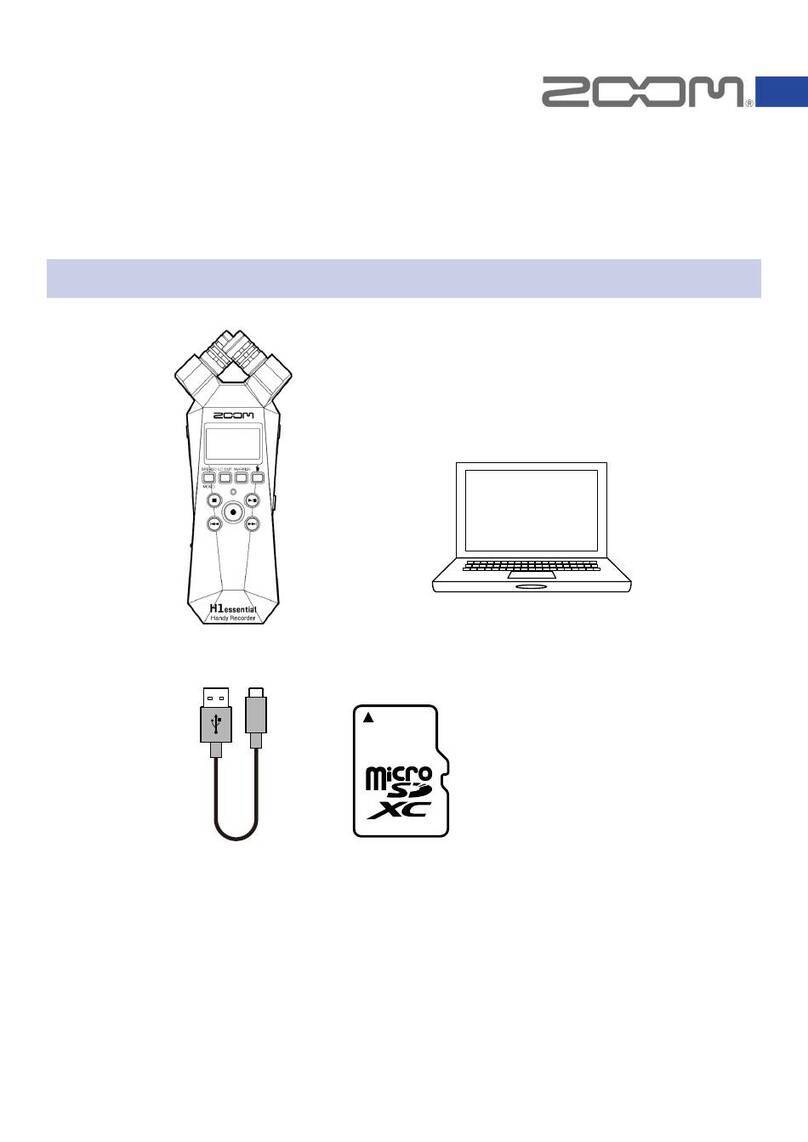
Zoom
Zoom H1essential Firmware update guide
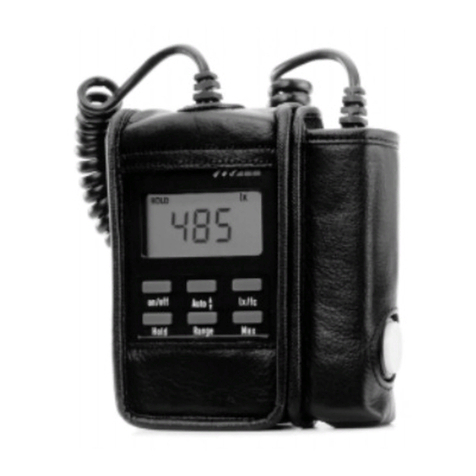
Gossen MetraWatt
Gossen MetraWatt MAVOLUX 5032C operating instructions

Rohde & Schwarz
Rohde & Schwarz CMW-KM75 Series user manual
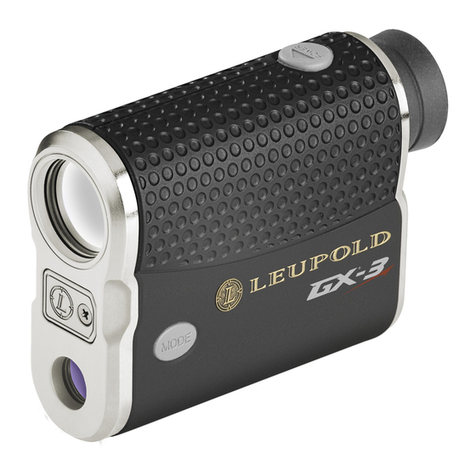
Leupold
Leupold GX-3 operating instructions
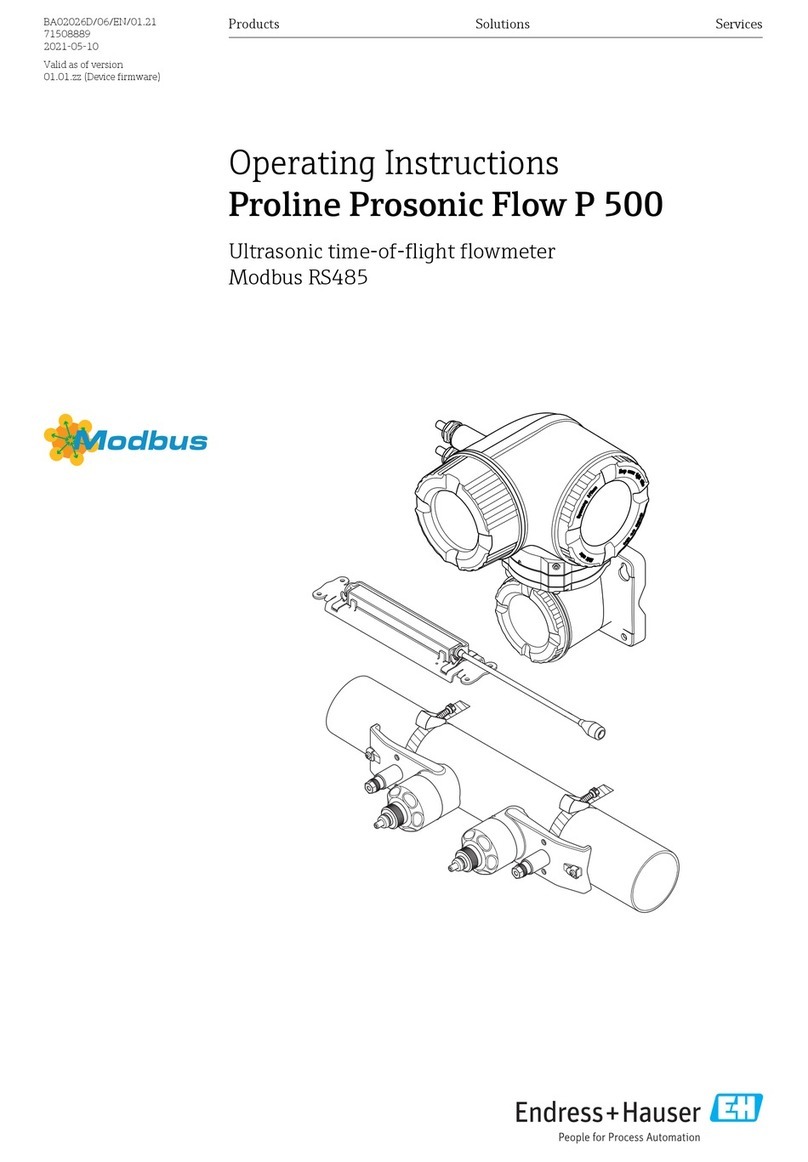
Endress+Hauser
Endress+Hauser Proline Prosonic Flow P 500 operating instructions

Endress+Hauser
Endress+Hauser prowirl 77 operating manual
